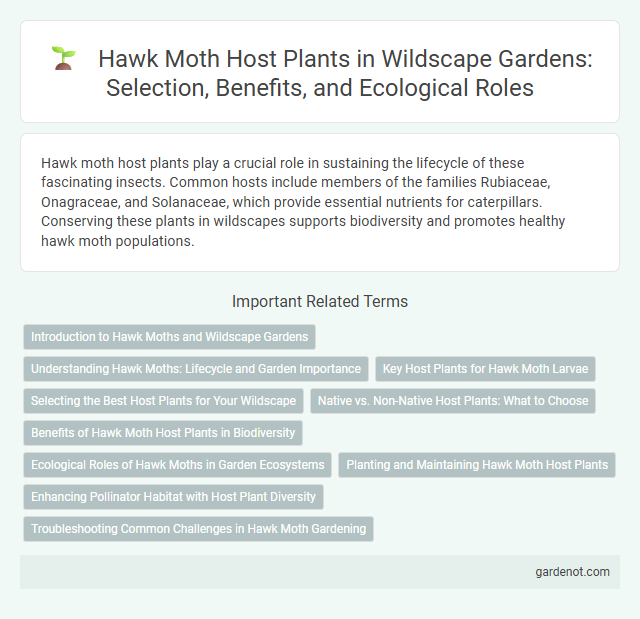Hawk moth host plants play a crucial role in sustaining the lifecycle of these fascinating insects. Common hosts include members of the families Rubiaceae, Onagraceae, and Solanaceae, which provide essential nutrients for caterpillars. Conserving these plants in wildscapes supports biodiversity and promotes healthy hawk moth populations.
Introduction to Hawk Moths and Wildscape Gardens
Hawk moths (family Sphingidae) are key pollinators within Wildscape Gardens, attracted specifically to night-blooming flowers such as evening primrose and fuchsia. These gardens are meticulously designed to include host plants like willowherb, honeysuckle, and bedstraw, which support the entire lifecycle of hawk moths from larva to adult. Incorporating native flora enhances biodiversity, promotes ecological balance, and provides essential nectar sources that sustain hawk moth populations throughout seasonal changes.
Understanding Hawk Moths: Lifecycle and Garden Importance
Hawk moths, belonging to the Sphingidae family, rely on specific host plants such as honeysuckle, moonflower, and various species of willowherb for their larval development. The lifecycle of hawk moths includes egg, larva (caterpillar), pupa, and adult stages, with caterpillars feeding predominantly on host plant leaves to accumulate energy for metamorphosis. These moths play a crucial role in pollination, supporting biodiversity by transferring pollen while feeding on nectar from night-blooming flowers in garden ecosystems.
Key Host Plants for Hawk Moth Larvae
Key host plants for hawk moth larvae include species from the families Solanaceae, such as tobacco (Nicotiana tabacum) and tomato (Solanum lycopersicum), which provide essential nutrients for larval development. Other important hosts are members of the Rubiaceae family, like bedstraw (Galium spp.), and the Onagraceae family, including willowherb (Epilobium spp.). These plants support hawk moth biodiversity within wildscape habitats by sustaining larval growth and survival.
Selecting the Best Host Plants for Your Wildscape
Choosing the best host plants for hawk moths in your wildscape involves selecting native species such as grapevine (Vitis spp.), willow (Salix spp.), and olive (Olea europaea) that cater to various hawk moth caterpillar species. These plants provide essential nutrients for larval development and support pollination activities, enhancing ecosystem biodiversity. Incorporating a diverse range of host plants ensures a stable food source and encourages a thriving population of hawk moths in your habitat garden.
Native vs. Non-Native Host Plants: What to Choose
Selecting native host plants for hawk moths significantly benefits local ecosystems by providing suitable nutrition and habitat tailored to the moths' life cycles, promoting biodiversity and supporting native insect populations in wildscapes. Non-native host plants may offer alternative food sources but often lack the chemical and structural properties necessary for optimal larval development, potentially disrupting native moth populations and associated wildlife. Prioritizing native flora ensures a balanced ecosystem, enhancing conservation efforts and maintaining the natural symbiosis between hawk moths and their environment.
Benefits of Hawk Moth Host Plants in Biodiversity
Hawk moth host plants play a crucial role in enhancing biodiversity by supporting the life cycle of various hawk moth species, which serve as important pollinators for nocturnal flowers. These plants contribute to ecosystem stability by providing food sources for larvae and adults, fostering a balanced food web that includes predators and other pollinators. The presence of diverse hawk moth host plants promotes genetic variation and resilience among local flora, aiding habitat restoration and conservation efforts within wildscapes.
Ecological Roles of Hawk Moths in Garden Ecosystems
Hawk moths serve as vital pollinators in garden ecosystems, transferring pollen between flowers like petunias, jasmine, and garden phlox, which helps sustain plant biodiversity. Their larvae, commonly found on host plants such as tomatoes, tobacco, and evening primrose, contribute to natural pest control by forming part of the food web that supports birds and predatory insects. These ecological roles enhance plant reproduction and support healthy garden biodiversity, making hawk moths essential components of sustainable ecosystem functioning.
Planting and Maintaining Hawk Moth Host Plants
Planting and maintaining hawk moth host plants like willowherb, bedstraw, and honeysuckle ensures a vital food source for hawk moth larvae. These plants thrive in well-drained soil with ample sunlight and regular watering during dry periods to promote healthy growth. Regular pruning and monitoring for pests help sustain plant vigor, supporting the lifecycle of hawk moths within the wildscape habitat.
Enhancing Pollinator Habitat with Host Plant Diversity
Hawk moths rely on diverse host plants such as evening primrose, petunia, and jasmine to complete their life cycle, making host plant diversity critical for supporting their populations. Integrating a variety of native nectar-rich plants in wildscapes enhances pollinator habitat by providing essential resources for both adult moths and their larvae. Promoting a range of host plants increases ecosystem resilience, supporting pollination services vital for biodiversity and crop production.
Troubleshooting Common Challenges in Hawk Moth Gardening
Hawk moths primarily rely on host plants such as bedstraw (Galium), willowherb (Epilobium), and grapevine (Vitis) for larval development, making plant selection critical in wildscape gardens. Common challenges include larval predation, disease outbreaks, and inadequate host plant availability, which can be mitigated through integrated pest management, regular monitoring, and diversified plantings. Ensuring a pesticide-free environment and maintaining high plant health supports sustainable hawk moth populations in garden ecosystems.
Hawk moth host Infographic

 gardenot.com
gardenot.com